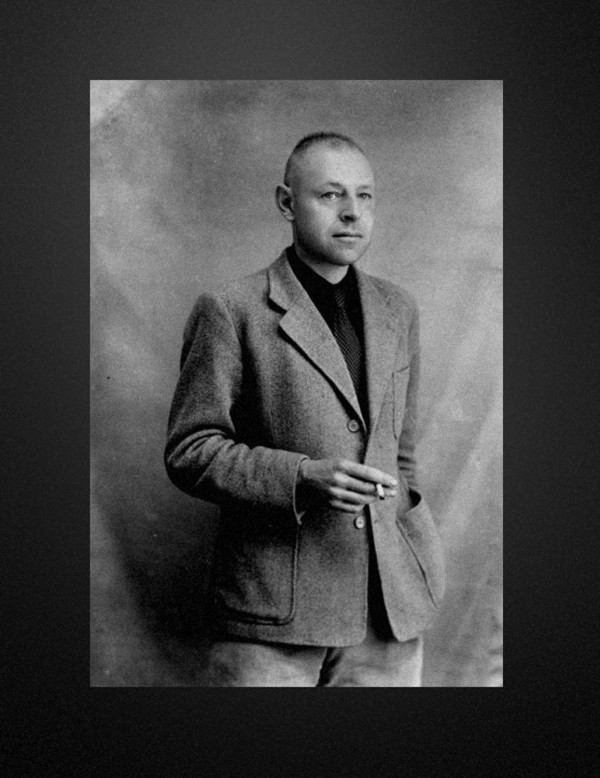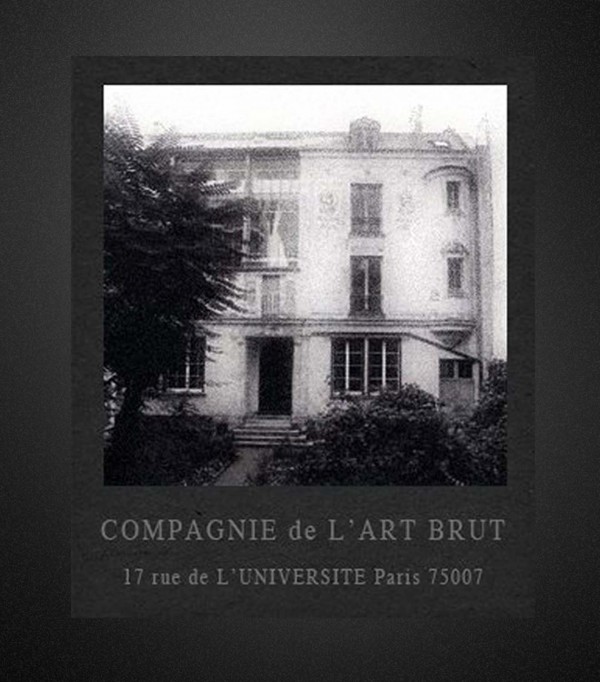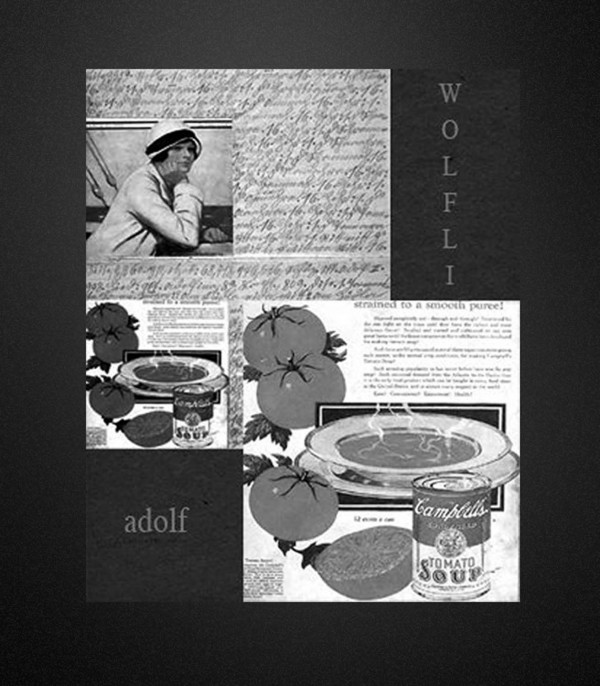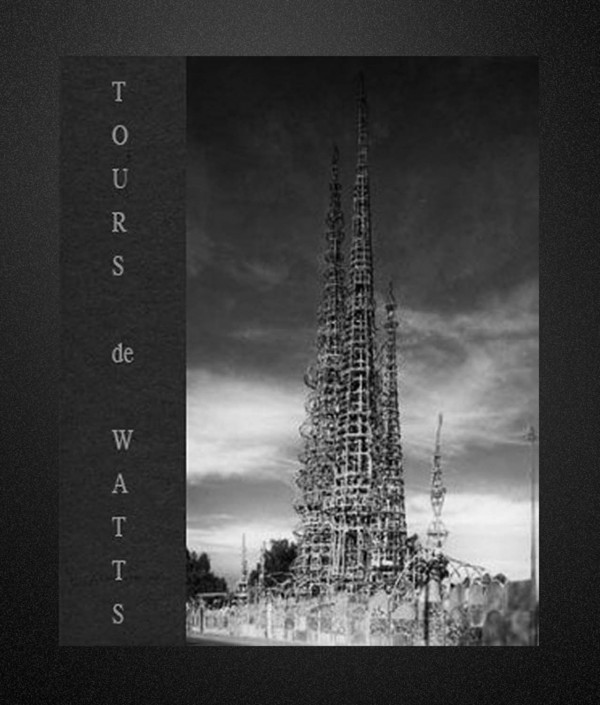Origin of Art Brut
History of art brut began at the end of the Second World War. It’s actual birth, however, has been surrounded by certain unclarity. Jean Dubuffet’s trip to Switzerland from 5 July until 22 July 1945, in the company of Jean Paulhan and Le Corbusier, was of decisive importance. In his Guide d’un petit voyage en Suisse, [Guide of a small journey in Switzerland], published in 1947, Paulhan recounted how Dubuffet “ran around in the asylums” and that he acquired “different drawings and gouaches”. The recent discovery of Dubuffet’s letter addressed to Raymond Queneau, anterior to this journey, testifies, however, that Dubuffet’s research went back at least to the spring of 1945. At that time Dubuffet was already searching for information regarding Auguste Forestier, one of whose sculptures was in the possession of the poet Paul Eluard, whom Dubuffet met in the spring of 1944. Eluard, who had to hide during the war in the mental hospital of Saint-Alban in Lozère, had doubtlessly discovered Forestier. The curiosity of the Surrealist collector, enjoying the objective coincidence of the discovery of the work as much as its possession, would be replaced by Dubuffet’s systematic research, doubled by intense theoretical and promotional activity. Dubuffet did not hesitate to take advantage of his business experience, acquired before his artistic career. In anticipation of the universal character of art brut, his enterprise would receive European and international scope.
One Definition, Two Criteria
Art brut, in our prejudiced view, causes trouble. It retains the salubrious capacity to combine two heterogeneous criteria in its definition. A sociological criterion: the productions described as art brut are made by “humble persons, strangers to the professional artistic circles” (La Compagnie de l’Art Brut, text from1963). An aesthetic criterion: these productions possess “spontaneous and strongly inventive character, which owes very little to habitual art or clichés”. All the richness and ambiguity of the concept of art brut are thus exposed. From the two, it is not the sociological criterion that is the most problematic. It is quite easy to find out whether or not someone belongs to the corporative seraglio of art, even if the today generation of artists is reluctant to display its apprenticeship. It is less easy to judge if the creation has been touched by the spirit of discovery. What is actually the meaning of Dubuffet’s assertion, according to which the creations of art brut “appeal to the primary human depths”? What does he mean when he says that the creators of art brut draw their themes, ideas and means of expression from their “own resources”, from their “impulses and humours, without referring to the usual means, without any consideration for the accepted conventions”? This means Carlo, Darger, Domsic, Grünenwaldt, Hodinos, Monsiel and others. Each of these works enriches and modifies, in its own way, the definition of art brut.
A Concept
A stroke of inspiration, art brut hits the nail on the head because it condenses several levels of meaning in two simple words. Similarly to the notion of theunconscious in the case of psyche, the signifier in the case of language, or pensée sauvage (savage thinking) in reference to primitive societies, the concept of art brut shows its efficiency by operating a new division in the field of reality. It already draws its legitimity from questioning the principles that govern this reality. Art brut is not the sum of art of the insane + art of the psychics + art of the prisoners + self-taught art + all art of the illiterate. There exist drawings of perfectly delusional patients which lack the originality with which some other creators can invest their beliefs and therefore cannot be described as art brut. Art brut gathers in an organic, protean and complex totality works issued from the afore mentioned artistic families under the condition that they manifest invention. Art brut is thus a globalising concept. As it reveals the universally acknowledged distictions as void and illegitimate, it ends up, paradoxically, in creating a new division in the art field. By accomplishing this, it creates meaning. From the point of view of the spectator, it expresses the irruptive disclosure, violence and fascination radiating from these creations. From the point of view of the author, it accounts for the proximity of the work with the original psychic materials that would remain under other circumstances hidden under the banality or eccentricity of the ordinary life.
Arbitrary Divisions / Beneficial Proximity?
Instead of bringing offering ready-made answers, art brut invites us to ask a number of questions. Unlike the unanimism of the surface in which everything seems to be the same in the world of creation, art brut considers submission to the taste of the majority a mediocre virtue. It invites us to separate the wheat of true invention from the chaff. There is, however, no ostracism attached to this process. Art brut refrains neither from abstract (Palanc) nor from minimal expression (Oswald Tschirtner). Skilful in disregarding the taboo of the “right” and “bad” practice, stimulated by the lack of means and with no inclination to regard the traditional materials as sacred, the creators of art crut can create the impression of being ahead of their time in the artistic forms and techniques. In the mental hospital of Heidelberg, Marie Lieb made installations on the floor of her room already in 1894. Those blaming art brut for operating arbitrary divisions are often those who are well aware of the benefits contemporary art can draw from the proximity with art brut. However, there is as much distance between a machine of Heinrich Anton Müller and a meta-mechanical sculpture of Jean Tinguely as between an African mask and Les Demoiselles d’Avignon. This does not, of course, mean that Picasso or Tingely are bad artists, it only means that they develop in a different dimension. Art brut is, according to us, not systematically opposed to contemporary art. It may even communicate with contemporary art, similar to radically opposed planes, as for example in the irregular perspectives of the engraver Maurits Cornelius Escher whose figures are never sure – after having climbed up the stairs – whether they are not one floor below. In the discourse of the culture that has gained majority in contemporary art, art brut contributes with the dimension of a lapsus, of a Freudian slip.
Culture
Far from relying on certitudes, abcd wishes to question the true problems inherent in the notion of art brut. To evoke one of the principal questions, abcd argues that we have to examine the type of relation – or non-relation – art brut maintains with culture(s). If the intuition of Jean Dubuffet concerning this point was right, if he managed to pinpoint something essential, it is to be noted that the conflicting turn present in his analyses which he adopted in order to mark the epistemological break, did not allow him to make completely explicit the blatant otherness of art brut. Very quickly, his adversaries noted that Aloïse was far from being illiterate and that Adolf Wölfli, similarly to Andy Warhol, used in his collages the image of Campbell soup. In spite its seeming pertinence, such objection remains superficial. The integration of cultural elements in the work of art brut, far from leading to any effect of quotation or reference, operates in the service of the autarkical expression of the creative subject. The borrowings of art brut from culture, especially from folk culture, are of different nature; they function as the diurnal remains of a dream.
Factor of Crisis
All over the world, without considering the borders, social disparities, the contrast between balance and psychological troubles, there are writings or images (for the majority) that belong to the moving and complex domain of art brut. Everywhere where, behind the superficial diversity, reigns the official culture, there are creators whom the institutions refuse to consider as true artists and who, as a result of their taste or temperament, do not fit in the ordinary system of fine arts. Their excessive and furtive art, scary and strayed, honest and threatened, constitutes nevertheless the absolute affirmation of humanity behind magnificently individual forms. Art brut reacts, by means of high madness, to mental illness that invades this planet : standardization, productivity, cloning, demonetization, fanaticism. We recognize art brut in that it endangers the fallacious artistic consensus based on notions that are never examined under the pretext that they are well adapted to the social behaviour in our hyper industrial time. Especially the concepts of genius, specialist, education, museum, money and perpetuity.
In the Orbit
In the nebula of what has been called outsider art, the abcd shuttle has chosen to remain in the orbit of art brut, the mother planet. Not because it despises galactic confines or entertains the nostalgic regret of the cultural Big Bang of the mid-twentieth century, but because art brut, as it was defined by Jean Dubuffet and by Michel Thévoz, remains the most refreshing source where to quench our thirst for truth. Yet access to this source has become more difficult. Parasitic meanings have gathered around the original definition. Because of gradual shifts we have sometimes confused art brut with the so-called self-taught art that is often the art of those whose ambitions do not match their level of talent or who were not accepted by art galleries. For not participating in the small world of intellectuals is not enough to make creative art. To create far from distribution channels does not automatically guarantee victory over banality and mediocrity. It is not because art brut denounces aesthetic artistic approach, imprisoned in its scholarly affiliation, concerned with social parades and not with authentic research, that the humble, the poor, the excluded can all be taken to guarantee a cultural virginity, more improbable every day. In this context, abcd strives to help restore essential readability. It is against comments or insufficiently thought out exhibitions. To react against the current trend diluting art brut in superficial rebellion, a pseudo-democratic friendly aesthetic, the simple culture of proximity, is one of the least prerequisites. Experience shows that art brut, when not falsified beforehand, meets the needs of a public that seeks authenticity.








